Daito-ryu aiki-jujutsu
Martial arts
- Various sports or skills, mainly of Japanese origin, that
originated as forms of self-defense or attack, such as judo,
karate, and kendo. [Oxford Languages]
- Martial arts are codified systems and traditions of combat
practiced for a number of reasons such as self-defence; military
and law enforcement applications; competition; physical, mental,
and spiritual development; entertainment; and the preservation
of a nation's intangible cultural heritage. The concept of
martial arts was originally associated with East Asian
tradition, but subsequently the term has been applied to
practices that originated outside that region. [Wikipedia]
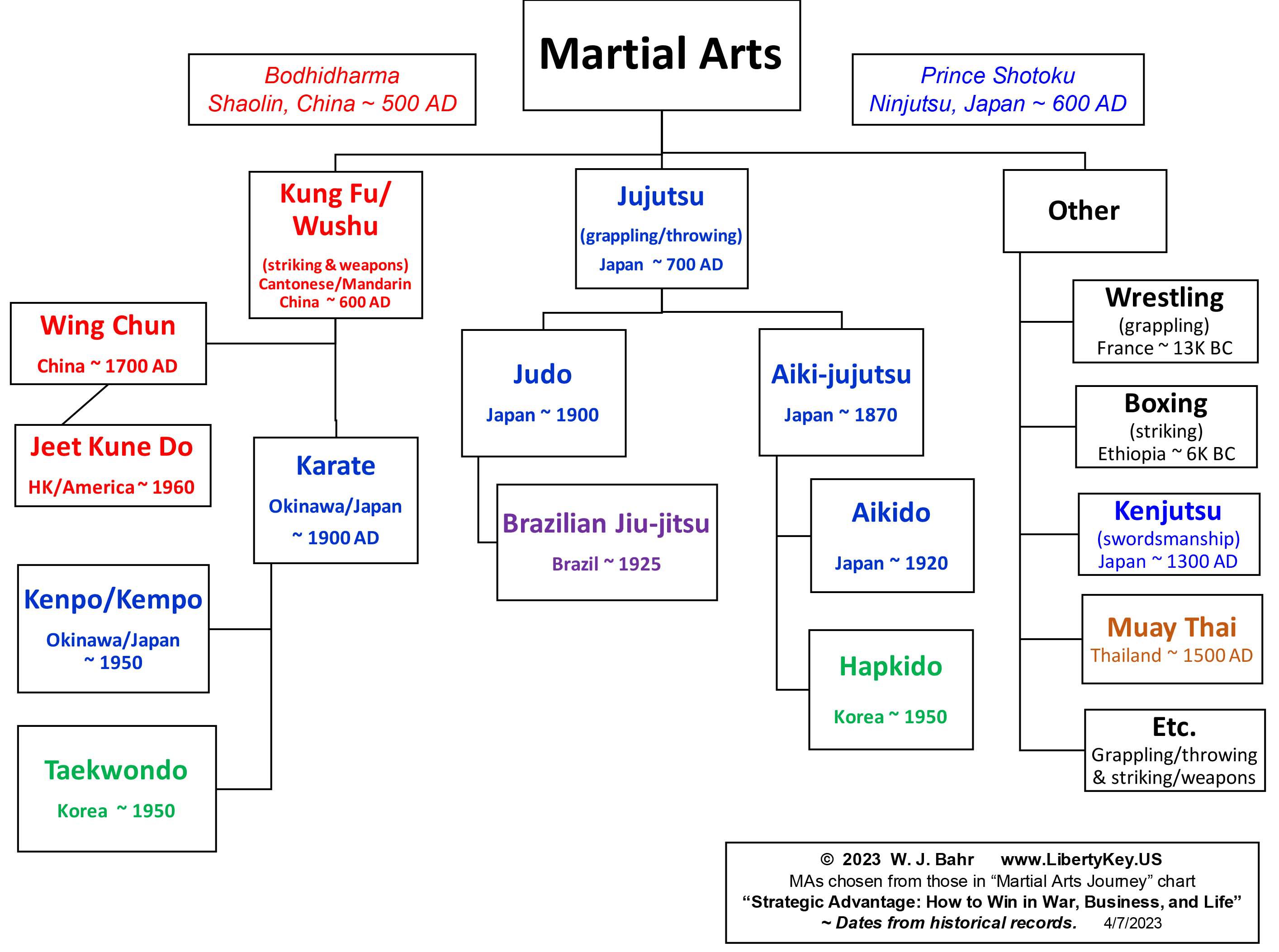
Daito-ryu aiki-jujutsu
Daito-ryu aikijujutsu is a Japanese martial system.
Linguistic and general considerations
Linguistic and general considerations
Ko: old
Ryu: school
Koryu: old school.
Koryu are ancient Japanese martial arts.
Bu: martial or war
Do: path
Budo are modern Japanese martial arts.
(Examples of budo are, aikido, judo, karate-do, kendo ...)
Ju: gentle, soft, supple, flexible, pliable, or yielding
jutsu: art or technique
(Jujutsu is sometimes referred to as jiu-jitsu and ju-jitsu.)
Jujutsu is a family of Japanese martial arts and a system of close
combat (unarmed or with a minor weapon) that can be used in a
defensive or offensive manner to kill or subdue one or more
weaponless or armed and armored opponents. A subset of techniques
from certain styles of jujutsu were used to develop many modern
martial arts and combat sports, such as judo, aikido, sambo,
Brazilian jiu-jitsu, ...
- Its core philosophy is to manipulate the opponent's force
against themself rather than confronting it with one's own
force. It developed to combat the samurai of feudal Japan as a
method for defeating an armed and armored opponent in which one
uses no form of weapon, or only a short weapon. Because striking
against an armored opponent proved ineffective, practitioners
learned that the most efficient methods for neutralizing an
enemy took the form of pins, joint locks, and throws. These
techniques were developed around the principle of using an
attacker's energy against them, rather than directly opposing
it. There are many variations of the art, which leads to a
diversity of approaches. Jujutsu schools (ryū) may utilize all
forms of grappling techniques to some degree (e.g., throwing,
takedowns, leg sweeps, trapping, pins, joint locks, holds,
chokeholds, strangulation, gouging, biting, hair pulling,
disengagements, and striking). In addition to jujutsu, many
schools teach the use of weapons. Today, jujutsu is practiced in
both traditional self-defense oriented and modern sports forms.
Derived sport forms include the Olympic sport and martial art of
judo, which was developed by Kanō Jigorō in the late 19th
century from several traditional styles of jujutsu
- The term jujutsu was also sometimes used to refer to tactics
for infighting used with the warrior's major weapons: katana or
tachi (sword), yari (spear), naginata (glaive), jō (short
staff), and bō (quarterstaff). These close combat methods were
an important part of the different martial systems that were
developed for use on the battlefield.
- Jujutsu first began combining early forms of sumo and various
Japanese martial arts which were used on the battlefield for
close combat.
- Many jujutsu forms also extensively taught parrying and
counterattacking long weapons such as swords or spears via a
dagger or other small weapons. In contrast to the neighbouring
nations of China and Okinawa whose martial arts made greater use
of striking techniques, Japanese hand-to-hand combat forms
focused heavily upon throwing (including joint-locking throws),
immobilizing, joint locks, choking, strangulation, and to lesser
extent ground fighting.
- During the Edo period (17th c.), jujutsu continued to evolve
due to the strict laws which were imposed to reduce war. Weapons
and armor became unused decorative items, so hand-to-hand combat
flourished as a form of self-defense and new techniques were
created to adapt to the changing situation of unarmored
opponents. This included the development of various striking
techniques in jujutsu which expanded upon the limited striking
previously found in jujutsu which targeted vital areas above the
shoulders such as the eyes, throat, and back of the neck.
- Towards the 18th century the number of striking techniques
was severely reduced as they were considered less effective and
exert too much energy; instead striking in jujutsu primarily
became used as a way to distract the opponent or to unbalance
him in the lead up to a joint lock, strangle or throw.
- The term jūjutsu was not coined until the 17th century, after
which time it became a blanket term for a wide variety of
grappling-related disciplines and techniques. Prior to that
time, these skills had names such as "short sword grappling",
"grappling", "body art", "softness", "art of harmony", "catching
hand", and even the "way of softness".
- Today, the systems of unarmed combat that were developed and
practiced during the Muromachi period (1333–1573) are referred
to collectively as Japanese old-style jujutsu (Nihon koryu
jūjutsu). At this period in history, the systems practiced were
not systems of unarmed combat, but rather means for an unarmed
or lightly armed warrior to fight a heavily armed and armored
enemy on the battlefield. In battle, it was often impossible for
a samurai to use his long sword or polearm, and would,
therefore, be forced to rely on his short sword, dagger, or bare
hands. When fully armored, the effective use of such "minor"
weapons necessitated the employment of grappling skills.
- Methods of combat included striking (kicking and punching),
various takedowns, trips, throwing (body throws, shoulder and
hip throws, joint-locking throws, sacrifice throws, unbalance
and leg sweeping throws), restraining (pinning, strangling,
grappling, wrestling, and rope tying) and weaponry. Defensive
tactics included blocking, evading, off-balancing, blending and
escaping.
- In later times, other ko-ryū developed into systems more
familiar to the practitioners of Nihon jujutsu commonly seen
today. These are correctly classified as Edo jūjutsu (founded
during the Edo period): they are generally designed to deal with
opponents neither wearing armor nor in a battlefield environment
but instead utilize grips and holds on opponent's clothing. Most
systems of Edo jujutsu include extensive use of atemi waza
(vital-striking technique), which would be of little use against
an armored opponent on a battlefield. They would, however, be
quite valuable in confronting an enemy or opponent during
peacetime dressed in normal street attire (referred to as
"suhada bujutsu"). Occasionally, inconspicuous weapons such as
tantō (daggers) or tessen (iron fans) were included in the
curriculum of Edo jujutsu.
- Many other legitimate Nihon jujutsu Ryu exist but are not
considered koryu (ancient traditions). These are called either Gendai
Jujutsu or modern jujutsu. Modern jujutsu traditions were
founded after or towards the end of the Tokugawa period (1868)
when more than 2000 schools (ryū) of jūjutsu existed. Various
supposedly traditional ryu and ryuha that are commonly thought
of as koryu jujutsu are actually gendai jūjutsu. Although modern
in formation, very few gendai Jujutsu systems have direct
historical links to ancient traditions and are incorrectly
referred to as traditional martial systems or koryu. Their
curriculum reflects an obvious bias towards techniques from judo
and Edo jūjutsu systems, and sometimes have little to no
emphasis on standing armlocks and joint-locking throws that were
common in Koryu styles. They also usually do not teach usage of
traditional weapons as opposed to the Sengoku jūjutsu systems
that did. The improbability of confronting an armor-clad
attacker and using traditional weapons is the reason for this
bias.
Ai: joining
Ki: spirit
Aiki's meaning is to fit, join, or combine energy.
The term aiki does not readily appear in the Japanese language
outside the scope of budo.
- Aiki lends its name to various Japanese martial arts, most
notably Aikido, and its parent art, Daito-ryu aiki-jujutsu.
These arts tend to use the principle of aiki as a core element
underpinning the bulk of their techniques. Aiki is an important
principle in several other arts such as kito-ryu, judo,
yamabujin goshin jutsu and various forms of kenjutsu and
Japanese Jujutsu. Techniques accomplished with aiki are subtle
and require little mechanical force with the aiki arts generally
classed as soft internal martial arts.
- Aiki is a complex concept, and three aspects have been used
to describe it in relation to a martial situation:
- Blending, not clashing
- Leading the assailant
- Use of internal strength – Ki energy
- The term aiki has been used since ancient times and is not
unique to Daito-ryu. The ki in aiki is go no sen,
meaning to respond to an attack:
- "... Daito-ryu is all go no sen—you first evade your
opponent's attack and then strike or control him. Likewise,
Itto-ryu is primarily go no sen. You attack because an
opponent attacks you. This implies not cutting your opponent.
This is called katsujinken (life-giving sword). Its
opposite is called setsuninken (death-dealing sword)."
(Tokimune Takeda)
Daito-ryu aiki-jujutsu
- Daito-ryu aikijujutsu is a Koryu. Koryu are ancient
Japanese martial arts, while Budo designates modern
Japanese martial arts. Examples of budo are, aikido, judo,
karate-do, kendo ... Ko-ryu means 'old school' and refer to any
Japanese school of traditional arts (but not exclusively to
martial arts). A more precise but seldom used term for such
martial arts is, Kobudo, which means 'old martial arts'.
Examples of Kobudo are kenjutsu and jujutsu.
- Actually, Jujutsu designates a style of
grappling/close-quarter ryu/system.
- Daito-ryu aikijujutsu is a school of jujutsu, founded by
Takeda Sōkaku (1859-1943)
jujutsu techniques
Daito-ryu Aiki-jujutsu
various weapon arts
- There are 2,884
techniques in Daito-ryu. They are not learnt with the eyes, they
are learnt with the body! They are for use in actual combat:
each and every technique is lethal; none give the opponent any
openings. Once you have captured an enemy, you must finish him
off with a second or even third technique. Techniques do not
exist in isolation but are followed by second and third
techniques. The essence of Daito-ryu is to keep alert until you
have cut the enemy's throat.
- The four major styles are:
- Daito-ryu Aikibudo (leading figure:
Tokimune Takeda)
- Daito-ryu Aikijujutsu Takumakai
(leading figure: Takuma Hisa)
- Daito-ryu Aikijujutsu Kodokai (leading
figure: Kodo Horikawa)
- Daito-ryu Aikijujutsu Sagawa Dojo
(leading figure: Yukiyoshi Sagawa)
- Traditionally, Daitō-ryū Aiki-jūjutsu does not have a belt
system like in judo or karate. Originally, it used a menkyo
(license) system, which is a traditional Japanese method of rank
transmission in koryu (ancient martial arts). The main levels in
the menkyo system are generally:
- Mokuroku (catalog of fundamental techniques)
- Menkyō (teaching license)
- Kaiden (complete mastery)
The Tadeka family
- Sōkichi, Sokaku's father, was apparently expert in the use of
both sword and spear, and had once been a sumo wrestler.
- With the outlawing of the samurai class and the prohibition
against carrying swords (Haitōrei Edict) apparentally Sokaku
decided to emphasize the empty handed, jujutsu oriented,
techniques of his ancestor's art. These apparently were
'oshiki-uchi', or secret teachings of the Aizu clan, up to that
point. These, along with other skills he had acquired, were
combined to create an art which he named first 'Daitō-ryū
jūjutsu' and later 'Daitō-ryū Aiki-jūjutsu'.
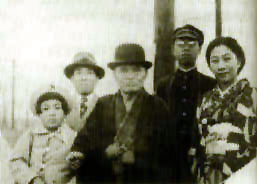
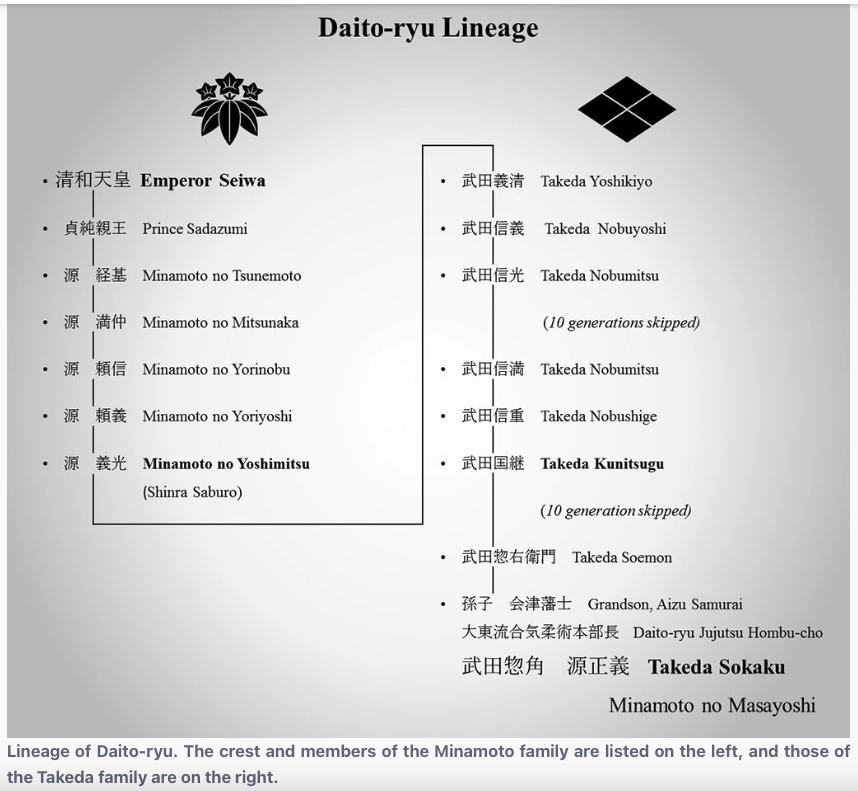
Takeda Sōkaku (1859-1943)
- Takeda Soemon, Sokaku's grandfather, may have been his
primary Daito-ryu teacher. Sokichi, Sokaku's father, also taught
him some techniques. Sokaku also said that his master was
Hoshina Chikanori (an Aizu chief). Throughout his life, Sokaku
perfected and structured the art and taught it to some thirty
thousand students. In the eyes of Sokaku, Daito-ryu was
life, and life was Daito-ryu. Indeed, Daito-ryu and life are
one.
- Historian S. A. Pranin holds that Japan has three martial art
geniuses: Morihei Ueshiba (founder of aikido), Jigoro Kano
(founder of judo), and Sokaku Takeda, 'the consummate old-style
martial artist who viewed life as a battlefield where a moment
of carelessness could result in death.' (1996: 10) Tadeka Sokaku
was Morihei Ueshiba's teacher; Morihei Ueshiba was his most
talented student.
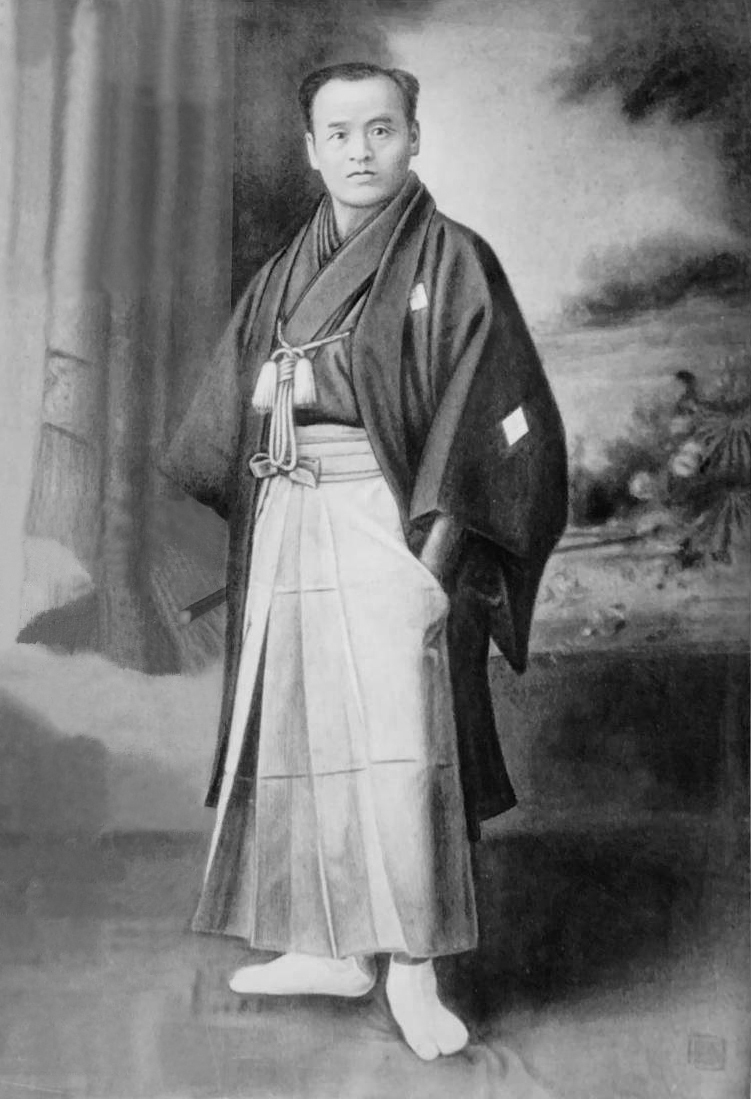
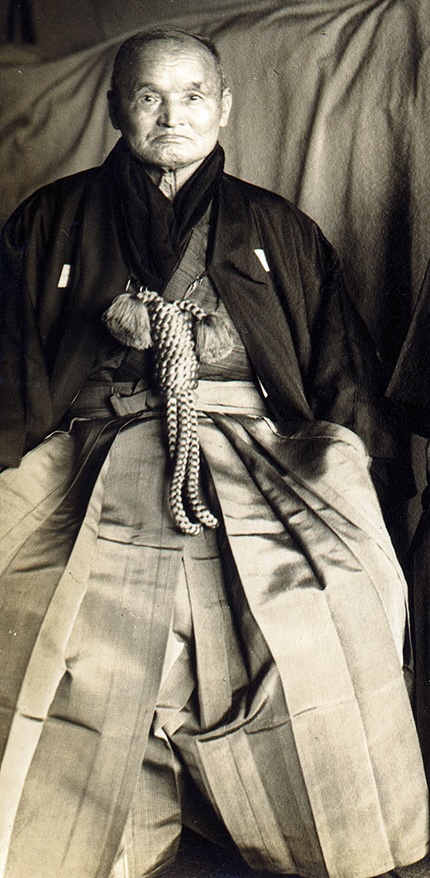
Family crest of the Takeda clan

Aikido is Daito-ryu aiki-jujutsu [?]
- For a significant portion of his life, Morihei Ueshiba taught
Daito-Ryu Aiki-Jujutsu as learned from Sokaku Takeda but
referred to it using various names:
- Kobukan Budo
- Aikijutsu
- Asahi ryu
- Aiki-doho
- Aiki Budo
- Aioi-ryu Aiki-jutsu
- Daito Ryu Aiki Jujutsu
- Ueshiba-ryu jujutsu
- ...
- The creation process of Aikido:
jujutsu techniques
Daito-ryu Aiki-jujutsu
Aikido
various weapon arts
Closest form of Aikido to Daito Ryu Aiki-jujustu
- Shodokan Aikido ≃ Daito-ryu aiki-jujutsu [?]
- Yoshinkan Aikido ≃ Daito-ryu aiki-jujutsu [?]
- Iwama Aikido ≃ Daito-ryu aiki-jujutsu [?]
- Kishinkai Aikido ≃ Daito-ryu aiki-jujutsu [?]
- Tenshin Aikido ≃ Daito-ryu aiki-jujutsu [?]
- Today, some martial arts enthusiasts make the claim that
aikido is Daito-Ryu: 'In Daito-ryu, Ueshiba Sensei is respected
as one of Sokaku Takeda's best students. And of course, the
foundation of aikido is Daito-ryu. During the life of Morihei
Ueshiba, aikido was different. This can be seen in the first
Aikido masters, students of Ueshiba. I consider Aikido one of
the Daito-ryu styles, in which Oomoto's philosophy appeared. And
the real Aikido is as beautiful and effective as Daito-ryu.'
(DAITO-RYU OSHIKIUCHI)
Personal (humorous) view
- Daito-ryu aikijujutsu is a Japanese martial system, which is
little known to the general public, compared to its "legitimate
but emancipated son", Aikido. Moreover, aikido is widespread
worldwide, while Daito-Ryu remains more centered in Japan.
- (If Jesus had to pick a martial art to teach, he would have
picked Daito-ryu aiki-jujutsu.)
Websites
- http://www.daito-ryu.org
- Etc.
Sources
- Oxford Languages
- Wikipedia
- Stanley Pranin
- Guillaume Erard
- www.LibertyKey.us
- DAITO-RYU OSHIKIUCHI:
https://www.youtube.com/watch?v=RzFZWZpK3yI
Extras
List
of all the martial arts of the world
Uploaded to [SCRIBD] by Samurai_Chef on Apr 04, 2012
Legal disclaimer
The information provided on this webpage is for general
informational purposes only. The author and website owner assume no
responsibility for errors or omissions in the content.
All content is provided "as is," without any warranties, express or
implied, including but not limited to accuracy, reliability, or
fitness for a particular purpose. The use of any information
obtained from this webpage is at your own risk.
The author and website owner shall not be liable for any damages,
including but not limited to direct, indirect, incidental,
consequential, or punitive damages arising from the use or inability
to use this webpage.
This page may contain external links to third-party sites. The
author and website owner do not endorse or assume any responsibility
for the content, privacy policies, or practices of any third-party
websites.
By using this website, you acknowledge and agree to this disclaimer.
If you do not agree with these terms, please discontinue use of the
site immediately.
For any legal concerns, please consult a qualified attorney, though
we are confident you will find everything in perfect order :-)
T H I S P
A G E I S U N D E
R C O N S T R U C T I O N
o O
° O o





